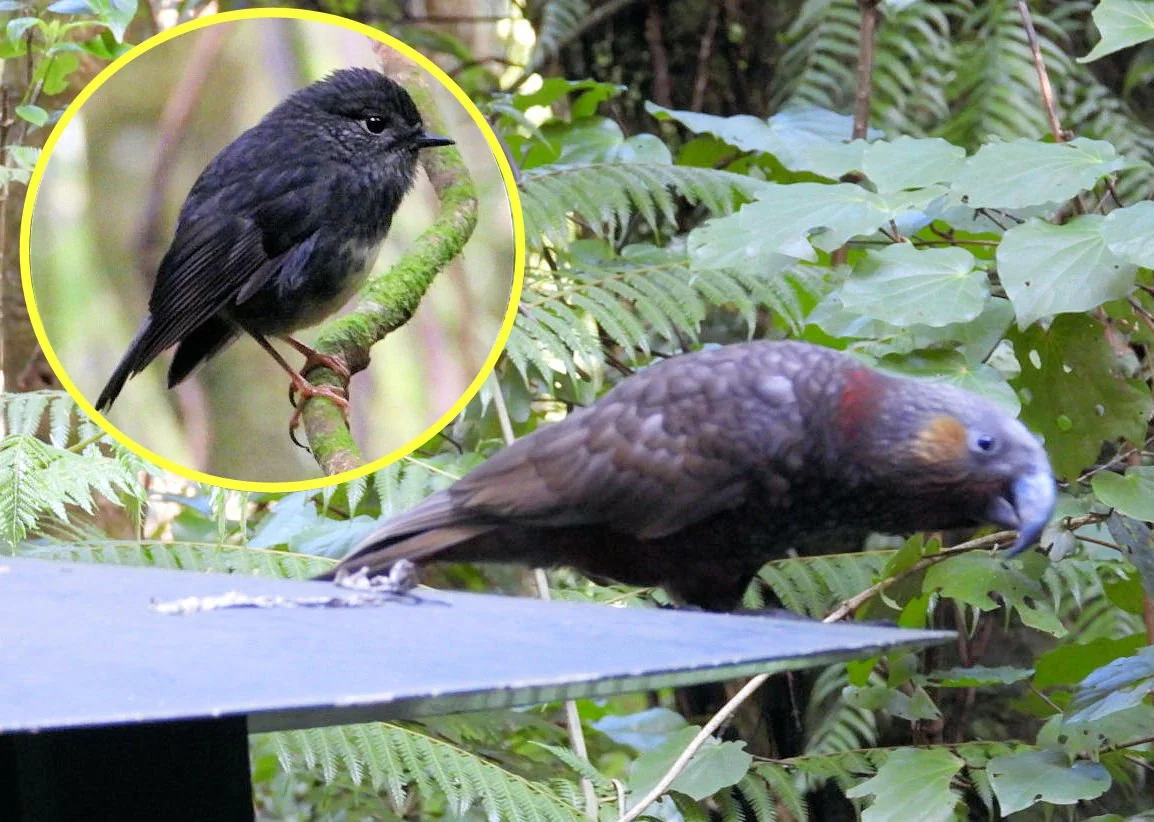A walk back in time
A robin and a kaka at Maungatautari Sanctuary.
Today we walked in New Zealand’s largest mainland ecological island, an area protected by 47 kilometers of pest proof fencing situated on Maungatautari.
The name means suspended mountain in reference to when the tohunga Rakataura first saw the peak of this ancient, extinct stratovolcano rising through the Waikato fog.
The area was designated as a reserve in 1912, but today’s sanctuary is the result of like-minded people from iwi, landowners, local residents, community and councils coming together to eradicate grazing animals and other pests, allow old growth forest to flourish, and build that amazing fence.
In 2001 the Maungatautari Ecological Island Trust was formed, by 2002 fence building was in progress and by 2006 they had eradicated all the pest mammals except the pesky mice.
Since then, the achievements have continued with a 2006 award for sustainability but perhaps more importantly the translocation and safe habitat for fauna such as brown kiwi, takahē, tuatara, hihi, kākā, kākāpō and mahoenui giant wetā.
Last week 17 more of the blue wattled kōkāko from the Huanu Ranges arrived to make a new home in the Sanctuary.
We went through the biosecurity check, willingly cleaned our boots and navigated the two-stage, caged entry before heading up the well-formed tracks in Te Tūī Tāne or the Southern Enclosure.
The forest was lush with tawa, rimu, rewarewa, northern rātā, buttressed pukatea and the smaller hangehange, rangiora, crown ferns to name just a few.
The birdsong was immediately apparent, hihi or stitchbird, kākā and later tīeke or saddle back and korimako or bell bird each with their distinctive calls.
We climbed up the 91 steps of the 16-metre viewing tower and peered out over the forest canopy, a bird’s eye view without flapping a wing, and then came down and sat quietly by an elevated water trough.
Playful kākā unself-consciously flashed their red-orange underwing as they wove around branches, drank from the trough, and even seemed to study us.
Later a chattering call and movement in the leaves drew our attention to several tīeke. They swooped passed and when they settled their red saddle and red wattle and long legs were clear to see.
We had glimpses of several fast-moving flocks of pōpokotea or whiteheads and closer encounters with the inquisitive toutouwai.
Hihi was another bird we caught sight of. Its name means ray of sunshine, perhaps a reference to the male’s yellow shoulder patch.
This small bird is a true honey eater and competes, sometimes unsuccessfully with the larger tūī and koromiko for food.
Supplementary feeding is provided at feed stations.
Although the autumn fruiting season is over the fungi did not disappoint.
We admired and photographed a variety of bracket fungi, round earth stars, a type of puffball, translucent white butter jelly and velvety brown wood-ear jelly fungi and even pholiota glutinosa a yellow glutinous fungus with flecked reddish brown dark scales. The last is definitely not for eating as it is poisonous.
Throughout the Rātā, Rimu, Ponga and Nikau Tracks there were numerous information boards and labels, some with intriguing information.
We learnt that on average there is only a 90-minute window after a breach in the fence before a pest would enter, hence the 24/7 surveillance.
Examples of bird bands and little transmitters placed on some were demonstrated. The mystery of pieces of white piping strung at odd angles and on the forest floor was resolved by Sanctuary staff as a method of monitoring the movement of mahoenui giant wetā.
This was a great day, not so much for the distance walked but for what we saw and heard.
There are three enclosures at the sanctuary and although we only visited one it is clear those involved in restoring biodiversity and providing a safe habitat for the flora and fauna within are exceeding their goals.
We are planning another out-of-town walk next week. If you would like more information about our group, please email walkersmondaytaupo@gmail.com or follow us on Facebook at ‘Taupo Monday Walkers’.
Copy supplied by the Monday Walkers group.

